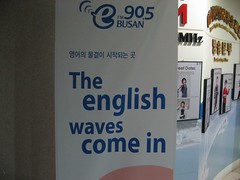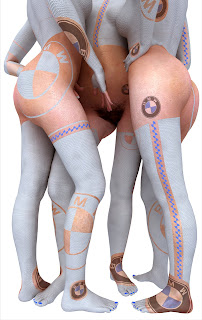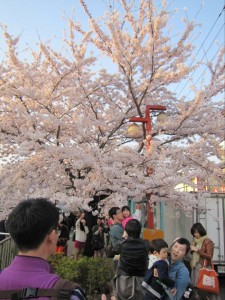Busan e-FM Week 28: National Identity
 About 'Open Mike in Busan'
About 'Open Mike in Busan'
Introduction
Well, unless you were hiding in a cave, this week has seen a huge global news event – the culmination of a ten year plan in fact. And someone who has proven difficult to pin down has finally been caught. I am of course, talking about Prince William and the British Royal Wedding. And this got me thinking about the subject of national identity – and what it means to be British in Korea.
Queen Elizabeth
I didn’t watch the royal wedding, but over 24 million British people did. The week before the wedding someone told me they weren’t watching it, and I didn’t even know when it was. Then I found out, because I received an email from one of my brokers covering the week ahead in the financial markets – and of course, the British stock market was closed.
According to a British newspaper survey, 37% of people in the UK were “genuinely interested and excited” by the wedding. That’s actually 23 million people – so presumably another 1 million watched because they were bored. A lot of people said it was a kind of Cinderella story, and I guess that Korean people can relate to that because many K-dramas seem to centre around a plot where a poor woman falls in love with a wealthy man, or a rich man falls in love with a poor woman, if you look at it from a male perspective, which often seems more important in Korea.
But if 37% were interested, it also means 63% were not really interested and didn’t watch, and I was one of them. I think to a lot of us our royal family is like a long running soap opera that refuses to get cancelled. But on the other hand, the queen is like our own version of a halmoni [elderly Korean woman] – stoically going on despite everything. So I accept she’s a national symbol. I guess Korea has it’s own modern-day royalty in a way, because I keep reading about ‘Queen Yuna” in the newspapers.
Queen Yuna
I didn’t watch the royal skating performance either, but I did see her Olympic performance last year, albeit accidentally. When she skated for the gold I was at a hospital having heart tests – but not because I was worried she wouldn’t win.
My wife told a friend that she might not have watched it if we hadn’t been at the hospital. She said her friend gave her an odd look. Maybe it’s not the sort of thing you’re suppose to admit to. I know there was a strong feeling of patriotism surrounding her performance – and I felt sorry for her because of that, because she’s very young and there must have been a lot of pressure on her; she’d become a national symbol but one, like the British royal family, that could easily disappoint. Of course we have had numerous disappointments with our royal family, and more than that, I’ve even had it with my government – and I’ve come to feel less British because of my experience.
The British Anti-Ambassador
I came to Korea to get married and then I was going to go home. Little did I know that by the time I set foot in England again my government would have done its best to prevent me from calling it home ever again, because they wouldn’t give my wife a visa and told me I was “free to live my life in Korea”. Those were the exact words with which I was effectively exiled. We won our legal case but there was no sense of victory after all the money and time we’d spent on the case. You know what the funny thing about governments is? When you break the law as a citizen, they send you to jail, but when they break the law (they did and I’m pretty sure they knew what they were doing as well), nobody goes to jail, and nobody apologises. That’s difficult when people expect you to be some kind of British representative.
Because there are relatively few British people here, I suppose sometimes I feel a sense that my behaviour and views are representing my country in Korea much more than they might be if I were American. So maybe I play this unwilling ambassadorial role. For example, an old Korean guy walked up to me while I was taking photos once, and after he discovered I was British he starts telling me how he owns a company and met the British Ambassador once – and how he gets invited to their parties sometimes.
I don’t get invited to parties at the British Embassy, and it’s a fair bet that there’s more chance of Kim Jong-il getting an invite than me. But this ajeossi tells me how much he likes British culture, and I’m trying to smile and be polite, but at the same time I’m thinking ‘why should I have to play this role after what happened?’ People say you tend to become more patriotic when you leave your country, but I became less.
National Identity Crisis
I might be having some kind of national identity crisis. It’s not like I feel welcome back home. What is it to be British in Korea anyway? Koreans have this notion of being a pure-blooded race ‘민족’, but there’s no British ‘race’ per se. Overseas Koreans are some of the most vocal defenders of Korean culture – even if they’ve never lived here, but I don’t think any British people really feel as strongly as that.
And there are lots of American brands here, with fast food, coffee and clothes retail. And what do the British get? One supermarket chain (Tesco Homeplus aka ‘Homeplus’ aka ‘Home plus’ aka ‘Samsung Tesco Homeplus’ aka ‘I can’t believe we’re not Korean’), and even that kind of hides its British origins. We can get a bit of British food there. There’s this kind of desperate discussion thread on a website for foreigners here (AFEK), where British expats talked in excited tones about being able to get their hands on tins of ‘Value Beans’ which are probably aroun 180 won in the UK but cost 1,000 won here.
Another problem with countries like Britain and America – wherever you are in the world, is that you also feel responsible for your country’s foreign policy – all the bad things that it does in your name. I think Korea doesn’t have that kind of issue as much.
The 51st State
I think my experience here is different from that of an American in some small ways. There’s always this worry in the background I think that American soldiers are going to get into serious trouble in Seoul – or American language teachers. But then often I get into taxis and the first question the driver will ask my wife is “is he American?” And you know, sometimes I sense this feeling of relief when my wife says no – he’s British. But I feel a bit bad about it as well, because the thing is with Brits and Americans is that we’re are all supposed to be on the same side now. Although you know what the truth of being British here is – we’re all Americans when we’re in trouble.
Links
Busan e-FM
Inside Out Busan
Air date: 2011-05-04 @ ~19:30
Busanmike.blogspot.com
Twitter: @BusanMike
YouTube: /BusanMikeVideo
Flickr: /busanmike













 RSS Feed
RSS Feed


Recent comments